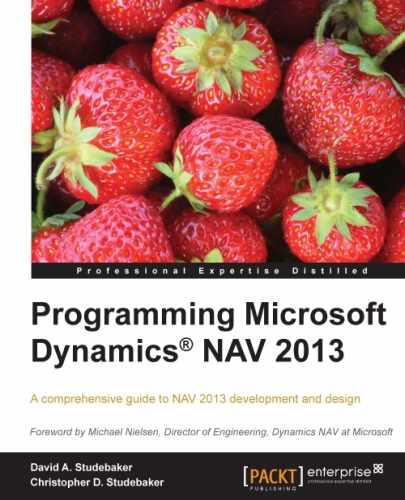Book Description
Experienced programmers and developers will find this the definitive guide to programming Microsoft Dynamics NAV. Both a reference book and a comprehensive hands-on tutorial, it will expand your knowledge dynamically.
- A comprehensive reference for development in Microsoft Dynamics NAV 2013, with C/SIDE and C/AL
- Brimming with detailed documentation that is additionally supplemented by fantastic examples
- The perfect companion for experienced programmers, managers and consultants
In Detail
Microsoft Dynamics NAV 2013 is a complete and robust ERP system that is accompanied by a comprehensive set of development tools. You will learn how to master these tools and tailor Microsoft Dynamics NAV 2013 to meet your customer’s specific business needs.
"Programming Microsoft Dynamics® NAV 2013" will lead you from start to finish, teaching you how to use this incredible ERP software whilst simultaneously making you a more productive developer. You’ll learn how to implement your solutions, as well as evaluating, managing and appraising Dynamics NAV 2013 productions and projects.
You will be empowered with the skills and knowledge that you need to get the job done and exceed your client’s expectations. Step by step, you will learn how to use NAV, master the C/AL programming language, as well as the construction and uses of each object type. Ultimately, you will be able to bring your NAV 2013 solution together with fantastic efficiency.
Hands-on development examples and additional material teach you by example and uncover the insider knowledge that only years of experience can provide, truly unleashing your productivity and potential.
Table of Contents
- Programming Microsoft Dynamics® NAV 2013
- Table of Contents
- Programming Microsoft Dynamics® NAV 2013
- Credits
- Foreword
- About the Authors
- Acknowledgements
- About the Reviewers
- www.PacktPub.com
- Preface
- 1. An Introduction to NAV 2013
- NAV 2013 – an ERP system
- Significant changes for NAV 2013
- A developer's overview of NAV 2013
- Developing in NAV 2013 – hands-on
- Summary
- Review questions
- 2. Tables
- An overview of tables
- Enhancing our sample application
- Creating and modifying tables
- Assigning a Table Relation property
- Assigning an InitValue property
- Adding a few activity-tracking tables
- New tables for our WDTU project
- New list pages for our WDTU project
- Keys, SumIndexFields, and table relations in our examples
- Modifying a standard table
- Version list documentation
- Types of tables
- Summary
- Review questions
- 3. Data Types and Fields
- 4. Pages – the User's Interactive Interface
- 5. Queries and Reports
- Queries
- Reports
- Report components – overview
- Report data flow
- Report components – detail
- Creating a Report in NAV 2013
- Summary
- Review questions
- 6. Introduction to C/SIDE and C/AL
- 7. Intermediate C/AL
- 8. Advanced NAV Development Tools
- 9. Develop, Debug, Deliver
- Creating new C/AL routines
- Multi-language system
- Multi-currency system
- Navigate
- Debugging in NAV 2013
- C/SIDE Test-driven development
- Other Interfaces
- NAV Application Server (NAS)
- Client Add-ins
- Customizing Help
- NAV development projects – some general guidance
- Design for efficiency
- Updating and upgrading
- Supporting material
- Summary
- Review questions
- A. Answers to Review Questions
- Chapter 1, An Introduction to NAV 2013
- Chapter 2, Tables
- Chapter 3, Data Types and Fields
- Chapter 4, Pages – the User's Interactive Interface
- Chapter 5, Queries and Reports
- Chapter 6, Introduction to C/SIDE and C/AL
- Chapter 7, Intermediate C/AL
- Chapter 8, Advanced NAV Development Tools
- Chapter 9, Develop, Debug, Deliver
- Index
